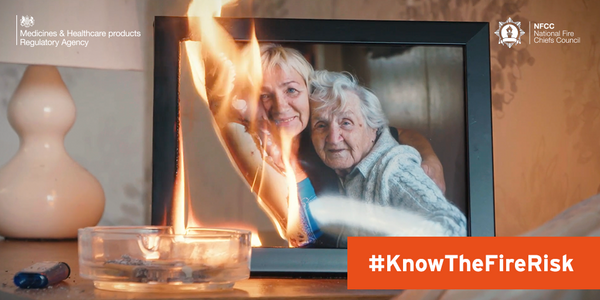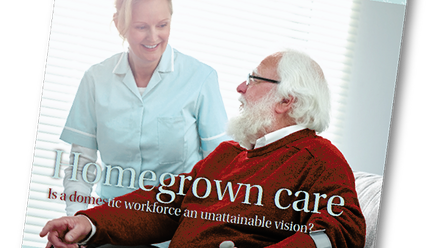Emollient skin creams - Guidance for homecare providers on fire safety

Updated 17 September 2025
This guidance covers the use of emollient skincare products in a homecare setting and is particularly concerned with identifying and minimising the fire risks associated with their use.
Emollients come in many forms including creams, lotions, ointments, body washes and bath additives.
The guidance reflects advice from the National Fire Chiefs Council (NFCC) and the Medicine and Healthcare Products Agency (MHRA). The term 'skin care creams and lotions' is sometimes used instead of 'emollients'.
The guidance was prepared for Homecare Association members with advice from NFCC and is available free to all domiciliary care providers.
It is intended to be guidance rather than instructions for those providing homecare.
Introduction
Between 2015 and 2022 there have been 78 confirmed fire deaths in Great Britain linked to emollients according to research by De Montfort University. Many of the people who died in emollient fires were older, many of whom had restricted mobility and a number of whom had care plans in place.
Emollients are widely used and are important for the treatment of skin conditions such as eczema, psoriasis and bed sores. Research has shown that fabric - such as clothing, towelling, bandages or bedding - contaminated with emollients containing paraffin, and emollients which contain no paraffin, such as those made with natural oils, burn quicker and hotter than fabric which has not been contaminated.
Care providers and practitioners can employ the principles outlined in this document in their policies, care planning and risk assessment processes. The approach needed for individual people’s care will vary from case to case according to specific circumstances. For example, some people receiving homecare services may be more willing and/or able to adopt safer practices than others.
What are skin care creams and lotions used for?
Skin care creams and lotions are non-cosmetic moisturising treatment which is applied to the skin. Often, they are prescribed by a person’s GP, but they are also available without prescription. Skin care creams can also come in the form of ointments and gels and are used to manage dry skin conditions such as eczema or psoriasis where they are an important part of medical treatment.
Sometimes they are used under bandages as a recognised treatment to control the itching of more severe eczema.
Skin care creams and lotions may also be used to prevent and treat conditions such as pressure sores which are more common amongst people who are relatively immobile, or who have difficulty adjusting their position independently, and who therefore spend extended periods of time in bed or in a chair. Applying skin care creams and lotions directly onto affected skin also reduces water loss by covering it in a protective film.
What are the fire related risks of using skin care creams and lotions in a homecare setting?
The main risk to people who regularly use skin care products is that of accidental ignition which may be due to:
- smoking (vaping is preferred if people use emollients),
- the use of candles or incense sticks,
- being close to heat sources such as heaters or cookers,
Regular use of emollients can mean the products dries onto fabrics such as dressings, clothing and bedding which leaves residues which are not completely removed during laundering.
When exposed to a heat source such as matches, lighters, cigarettes or other heat sources these fabrics can ignite. Combining this with a condition affecting the ability to respond to, or escape from a fire, substantially increases the risk of serious injury or death.
Risk Assessment
The risks from using emollients should be considered using the NFCC's Initial fire risk checklist for domiciliary care providers and as part of the person’s care plan. A number of factors need to be taken into consideration. These factors include but are not limited to:
- the amount and frequency of application
- the ability of the person receiving homecare support to understand the dangers posed by certain behaviours such as smoking
In assessing potential risk, care staff should be mindful that the needs and wishes of the person are taken into account when carrying out a risk assessment with regard to the use of skin care products.
In addition, care staff should also observe the person's environment, and in particular whether there is any evidence that there have been any previous incidents of unsafe use or disposal of smoking materials such as burns or singe marks on bed linen, furniture, flooring or clothing.
Other factors for consideration should be:
- Whether and how much the person smokes
- The location that they smoke in
- Whether they are supervised whilst smoking and/or assisted to light cigarettes
- The method of lighting cigarettes
- The general health, awareness and dexterity of the person
- Whether they use any other medical aids which could contribute to the spread and intensity of a fire such as an airflow mattress
- Potential exposure to other sources of ignition such as cooking, candles, heaters.
Care Planning
The care plan of the person receiving homecare should take the findings of the Risk Assessment into account and clearly indicate their vulnerability in relation to the risks associated with the use of emollient skincare products, and the steps which should be employed to limit the risks.
The plan should include the person's preferences as far as they can be accommodated safely and involve all those concerned in the care of the person. If a person lacks the mental capacity to express their wishes or consent, then a ‘best interests’ decision may need to be made based on the Mental Capacity Act.
The care plan is however only effective where care workers follow the plan requirements and record their actions in the care log. Employers should satisfy themselves that this practice is embedded within their organisation.
An alert system should also be included to ensure that any changes to the care plan are clearly identified when they are made, and communicated to, and noted by the care workers.
The care plan should identify a safe system of work according to the user’s circumstances. For example, by limiting the person to smoking only when the care worker or another responsible person is present.
Example of a care plan risk assessment
Note: The term 'resident' is used below, but the risk assessment can be adapted for use where the person is supported by homecare services.
| Hazards and Risk Factors | Circumstances | Control Measures |
| Risk of fire because of the use of a skin care cream or lotion. | Resident smokes and has a skin care cream applied 3 times per day to her upper body. | Discussion around smoking cessation with family or suitable alternatives such as vaping or tobacco replacement products |
| Deep ashtray provided | ||
| There is a risk of cigarette dropping onto bedding/clothing and skin care product causing fire to spread quickly. | Fire Apron provided | |
| To smoke only when supervised | ||
| Fire retardant bedding supplied and fitted and replaced regularly | ||
| Laundering guidelines followed for bedding (including fire retardant bedding) and clothing | ||
| Resident uses an electric blanket | Removal of electric blanket – replaced with microwaveable heat pack | |
| Resident uses an airflow mattress to reduce pressure sores. | Advice given to resident not to smoke in bed, especially with the added risk of an airflow mattress | |
| Incontinence pads used which could potentially add fuel to any fire taking place. | Incontinence pads now stored in a cupboard close to the bed rather than stacked on a bedside table | |
| Resident has limited mobility which reduces her ability to escape should a fire occur. | Consideration of Telecare system linked to smoke detection – to discuss with family | |
| Consideration of Personal Protection (watermist/sprinkler) System – to discuss with family. |
How can the risk be mitigated?
Items which have come into direct contact with a skin care cream or lotion such as clothing, bed clothes and bed linen should be laundered daily minimise build-up of emollient residue. If dressings are used with a skincare cream or lotion, they should be changed daily. The following advice is also recommended to reduce the build-up of residues from fabrics:
- Wash items at the highest temperature possible allowed by the type of fabric (as shown on the care label)
- Be aware that although washing may reduce the build-up it will not completely remove it and so the fire risk will remain.
Home Fire Safety Visit
- Advice should be sought from the local Fire and Rescue Service who will provide a free Home Fire Safety Visit.
- You can do this by completing an online home fire safety check www.ohfsc.co.uk or contacting them directly
- Find your fire service | Fire England by entering a postcode.
- Find your local fire and rescue service | GOV.WALES
- Scottish Fire and Rescue Service
- Home - Northern Ireland Fire & Rescue Service
- Information will be provided about potential fire risks, and measures which can be put in place to keep these risks to a minimum. In addition, advice can be provided to the person receiving homecare services about how they can be alerted to a fire, and how to evacuate. Where possible, the person’s primary carer, or the care worker or other responsible person should be present during the Home Fire Safety visit. If necessary, a fire service may install smoke detection for the home and provide additional advice about suitable detection including specialist alarms. In addition, the need for other safety equipment such as flame-retardant bedding/apron, deep ashtrays and water misters/sprinklers will be assessed.
Resources and video training
The National Fire Chiefs Council has produced:
- Fire risk checklist for domiciliary care providers - NFCC.
- A Know the Fire Risk - NFCC webpage which has a section on emollient safety called Reducing Risk: Information for Carers and Support Workers (scroll down to read). This includes a video resource developed to help domiciliary care providers and support workers understand and reduce the fire risks linked to emollient use when providing care in people’s homes. (Please note some of the content is distressing as it discusses fatalities.)
There is also an Online home fire safety check which provides a route for care providers to refer individual cases to the local fire service for advice, with their consent.
Other resources include:
- Safe use of emollient skin creams to treat dry skin conditions, Medicines and Healthcare Products Agency. This page contains additional resources, including a leaflet for individuals and families.
- Emollients and risk of severe and fatal burns: new resources available - GOV.UK (www.gov.uk)
- Fire safety for homecare providers - Questions and answers, Homecare Association.
- Person Centred Risk Assessment Checklist, London Fire Brigade.
Disclaimer






